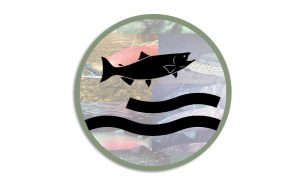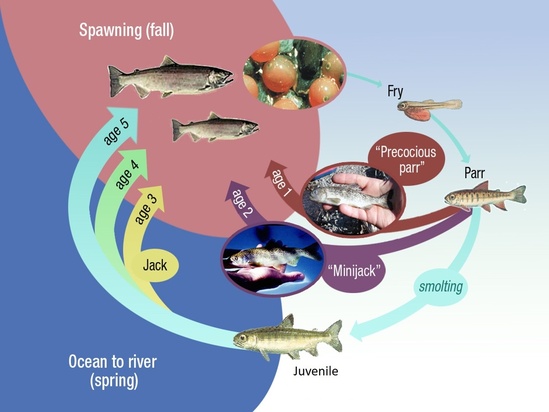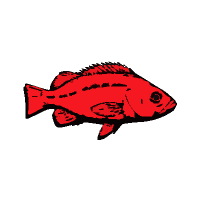Life History Patterns

[Last updated February 12, 2009.]
Where are the salmon?
There is much variation in life history patterns within a species and run of anadromous fish. Each stream system has fish populations with their own unique timing and patterns of spawning, growth, and migration. However, the table below provides a good summary of the most common timing for the fish listed. Chinook, coho, chum, pink, and sockeye salmon die soon after spawning. Steelhead and cutthroat trout, unlike the species we call “salmon” on the west coast of North America, may not die after spawning. They can migrate back out to sea and return in later years to spawn again.Generalized Life History Patterns of Salmon, Steelhead, and Trout in the Pacific Northwest
| Species | Spawning Location | Eggs in gravel | Young in Stream | Fresh-water rearing | |
| Young Migrate Downstream | Time in Estuary | Time in Ocean | Adults Return to Streams from Ocean | Adult Weight in lbs. (Avg) | |
| Coho salmon | coastal streams, shallow tributaries | October to May | 1+ years | tributaries, main stem side channels, and slack water | |
| March to July (of 2nd year) |
a few days to one month | 2 years | October to January | 5-20 (8) |
|
| Chum salmon | coastal rivers and streams, lower reaches | September to March | days to weeks | little time spent in freshwater | |
| shortly after young leave gravel | 7-14 days | 2.5-3 years | September to January | 8-12 (10) |
|
| Chinook salmon (spring run) |
large and small rivers | July to January | 1+ year | mainstem of large and small rivers | |
| March to July (of 2nd year) | days to months | 2-5 years | January to July | 10-20 (15) |
|
| Chinook salmon (summer run) |
large and small rivers | September to November | 1+ year | large and small rivers | |
| spring (of 2nd year) |
days to months | 2-5 years | June to mid-August | 10-30 (14) |
|
| Chinook salmon (fall run) |
large and small rivers | September to March | 3-7 months | large and small rivers | |
| April to June (of 2nd year) |
days to months | 2-5 years | August to March | 15-40 | |
| Coastal cutthroat trout (sea-run) | tiny tributaries of coastal streams | December to July | 1-3 years (2 avg) | tributaries | |
| March to June (of 2nd to 4th year) |
less than a month | 0.5-1 year | July to December | 0.5-4 (1) |
|
| Pink salmon | mainstem of streams, tributaries, and lower reaches | August to January | days to weeks | little time spent in freshwater | |
| December to May | few days | 1.5 years | July to October | 3-10 (4) |
|
| Sockeye salmon | streams, usually near lakes | August to April | 1-3 years | lakes | |
| April to June (of 2nd to 4th year) |
few days | 1-4 years | July to August | 3-8 (6) |
|
| Steelhead (winter run) |
tributaries and small streams and rivers | February to July | 1-3 years | tributaries | |
| March to June (of 2nd to 5th year) |
less than a month | 1-4 years | November to June | 5-28 (8) |
|
| Steelhead (spring run) |
tributaries and small streams and rivers | December to May | 1-2 years | tributaries | |
| Spring & summer (of 3rd to 4th year) |
less than a month | 1-4 years | February to June | 5-20 | |
| Steelhead (summer run) |
tributaries and small streams and rivers | February to June February to July |
1-2 years 1-3 years |
tributaries | |
| March to June (of 3rd to 5th year) March to June (of 2nd to 5th year) |
less than a month | 1-4 years | June to October (Columbia) April to November (coastal) |
5-30 (8) |
|
- Pearcy, William G. 1992. Ocean Ecology of North Pacific Salmonids. University of Washington Press, Seattle, WA. 179 p.
- Bell, Milo. 1986. Fisheries Handbook of Engineering Requirements and Biological Criteria. U.S. Army Corps of Engineers, Portland, OR. 290 p.
- Yates, Steve. 1988. Adopting A Stream; A Northwest Handbook. Adopt-A Stream Foundation, distributed by University of Washington Press. 11 p.
Additional resources:
- Willson, Mary F. 1997. Variation in salmonid life histories: patterns and perspectives.
Res. Pap. PNW-RP-498. Portland, OR: U.S. Department of Agriculture, Forest
Service, Pacific Northwest Research Station. 50 p (view here) - Bottom, D. L, 2008. Salmon life histories, habitat, and food webs in the Columbia River Estuary: an overview of research results, 2002-2006. Fish Ecology and Conservation Biology Divisions – Northwest Fisheries Science Center, National Marine Fisheries Service National Oceanic and Atmospheric Administration, Seattle, Washington. (view here)
- Western Fisheries Research Center-USGS. Life History of Pacific Northwest Fishes through Age and Growth Structures webpage (view here)


